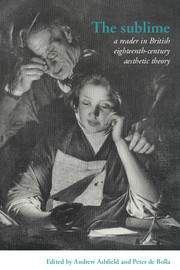Part III - Irish Perspectives
Published online by Cambridge University Press: 05 June 2012
Summary
One of the most intransigent problems in the conceptual mapping of the sublime is the relationship between the object taken to arouse heightened response and the affective quality of intense self-presence which results from such response. This problem is never satisfactorily resolved in the eighteenth-century tradition and indeed the ‘contentless content’ of the sublime continues to present difficulties in the post-Kantian tradition. Burke attempts to resolve the question through his assimilation of the self to the object, ‘the mind so entirely filled with its object’, thereby making self and the object taken to arouse the sublime sensation mutually containing. In this sense the sublime can be understood as a pulsation (which is why it is associated with the pulsation of consciousness in the post-Freudian tradition) in which first the conscious mind relinquishes its power over the world it perceives and in which it has experiential encounters in order to open itself to the object, to become suffused with the world. Then, in a secondary pulsation, this experience of opening up or of being overcome leads to an intensification of self-presence and a corresponding re-assertion of the power of the subject over the object [Burke]. This alternating location of the energy of the sublime, first all object then all subject, could be said to be an early precursor of more recent theories of the unconscious.
While this Burkean dynamic has certainly prevailed in the transmission of the sublime tradition it was not without its detractors and dissenters.
- Type
- Chapter
- Information
- The SublimeA Reader in British Eighteenth-Century Aesthetic Theory, pp. 127 - 130Publisher: Cambridge University PressPrint publication year: 1996

